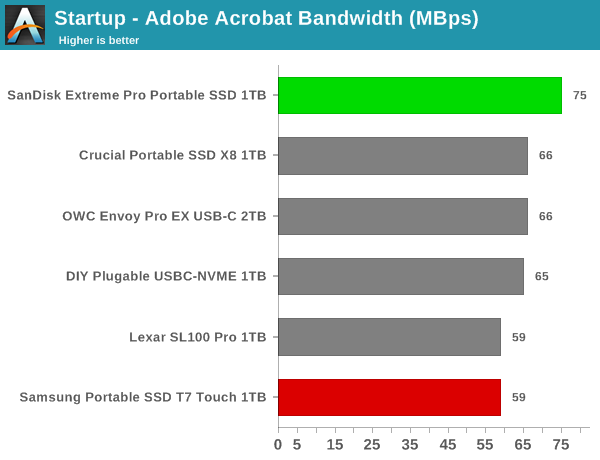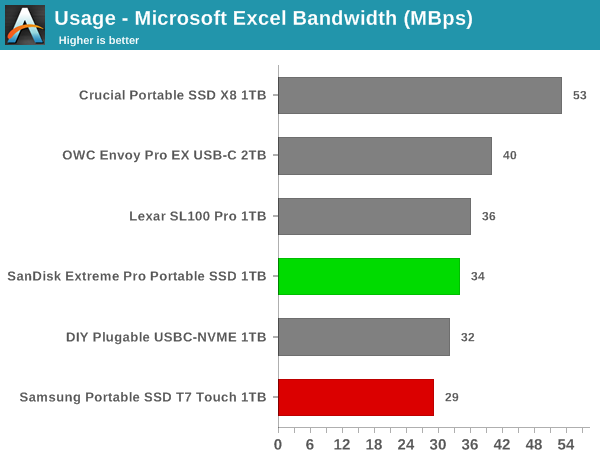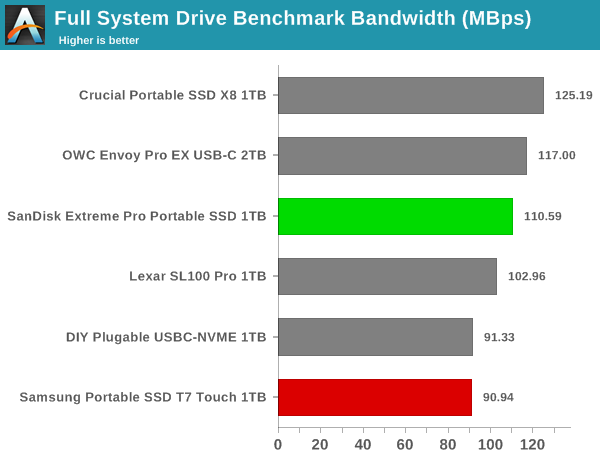USB 3.2 Gen 2 Portable SSDs Roundup - Featuring the Samsung T7 Touch and the SanDisk Extreme Pro
by Ganesh T S on January 23, 2020 9:00 AM ESTPCMark 10 Storage Bench - Real-World Access Traces
There are a number of storage benchmarks that can subject a device to artificial access traces by varying the mix of reads and writes, the access block sizes, and the queue depth / number of outstanding data requests. We saw results from two popular ones - ATTO, and CrystalDiskMark - in a previous section. More serious benchmarks, however, actually replicate access traces from real-world workloads to determine the suitability of a particular device for a particular workload. Real-world access traces may be used for simulating the behavior of computing activities that are limited by storage performance. Examples include booting an operating system or loading a particular game from the disk.
PCMark 10's storage bench (introduced in v2.1.2153) includes four storage benchmarks that use relevant real-world traces from popular applications and common tasks to fully test the performance of the latest modern drives:
- The Full System Drive Benchmark uses a wide-ranging set of real-world traces from popular applications and common tasks to fully test the performance of the fastest modern drives. It involves a total of 204 GB of write traffic.
- The Quick System Drive Benchmark is a shorter test with a smaller set of less demanding real-world traces. It subjects the device to 23 GB of writes.
- The Data Drive Benchmark is designed to test drives that are used for storing files rather than applications. These typically include NAS drives, USB sticks, memory cards, and other external storage devices. The device is subjected to 15 GB of writes.
- The Drive Performance Consistency Test is a long-running and extremely demanding test with a heavy, continuous load for expert users. In-depth reporting shows how the performance of the drive varies under different conditions. This writes more than 23 TB of data to the drive.
Despite the data drive benchmark appearing most suitable for testing direct-attached storage, we opted to run the full system drive benchmark as part of our evaluation flow. Many of us use portable flash drives as boot drives and storage for Steam games. These types of use-cases are addressed only in the full system drive benchmark.
The Full System Drive Benchmark comprises of 23 different traces. For the purpose of presenting results, we classify them under five different categories:
- Boot: Replay of storage access trace recorded while booting Windows 10
- Creative: Replay of storage access traces recorded during the start up and usage of Adobe applications such as Acrobat, After Effects, Illustrator, Premiere Pro, Lightroom, and Photoshop.
- Office: Replay of storage access traces recorded during the usage of Microsoft Office applications such as Excel and Powerpoint.
- Gaming: Replay of storage access traces recorded during the start up of games such as Battlefield V, Call of Duty Black Ops 4, and Overwatch.
- File Transfers: Replay of storage access traces (Write-Only, Read-Write, and Read-Only) recorded during the transfer of data such as ISOs and photographs.
PCMark 10 also generates an overall score, bandwidth, and average latency number for quick comparison of different drives. The sub-sections in the rest of the page reference the access traces specified in the PCMark 10 Technical Guide.
Booting Windows 10
The read-write bandwidth recorded for each drive in the boo access trace is presented below.

The Crucial X8 appears to be the best of the lot for this workload, while the other new drives are clustered between 104 MBps and 120 MBps. Given the amount of data traffic involved, the gulf is unlikely to result in a major difference in the boot times with various drives.
Creative Workloads
The read-write bandwidth recorded for each drive in the sacr, saft, sill, spre, slig, sps, aft, exc, ill, ind, psh, and psl access traces are presented below.

The SanDisk Extreme Pro Portable SSD offers the best startup times overall for different programs used in creative workloads. For usage after startup, the drive is a middling performer, though it comes out on top in a couple of relevant traces. The disappointing aspect is that the T7 Touch doesn't really shine as might be expected.
Office Workloads
The read-write bandwidth recorded for each drive in the exc and pow access traces are presented below.

The X8 wins out in the office workloads, with the SanDisk and Samsung units coming in the bottom half of the graph.
Gaming Workloads
The read-write bandwidth recorded for each drive in the bf, cod, and ow access traces are presented below.

The X8 again wins out here, with the Extreme Pro in the middle of the pack and the T7 Touch in the lower half.
Files Transfer Workloads
The read-write bandwidth recorded for each drive in the cp1, cp2, cp3, cps1, cps2, and cps3 access traces are presented below.

The X8 and the OWC Envoy Pro EX keeps coming on top for the file transfer cases. The Extreme Pro remains in the top half mostly, while the T7 Touch right behind it.
Overall Scores
PCMark 10 reports an overall score based on the observed bandwidth and access times for the full workload set. The score, bandwidth, and average access latency for each of the drives are presented below.

With an overall PCMark 10 full system drive benchmark score of 561, the T7 Touch comes in last among the considered DAS devices. The Extreme Pro scores a more respectable 683, but the Crucial X8 leas the pack with a 765.










38 Comments
View All Comments
lilkwarrior - Thursday, January 23, 2020 - link
Seems pointless to not be Thunderbolt 3 or USB4.avbohemen - Thursday, January 23, 2020 - link
I wonder what the limit is in the atto/as-ssd iops test. All drives hit a limit of 23-25k 4kB iops (atto) or 32k 4kB iops (as-ssd).Throughput is not saturated with 4kB iops and the drives are different enough in other benchmarks.
Is it a limitation of the usb/uasp protocol or the bridge chip, or something else?
avbohemen - Thursday, January 23, 2020 - link
Sorry, I mean crystaldiskmark instead of as-ssd.Soulkeeper - Thursday, January 23, 2020 - link
The crucial looked like the winner untill I saw the Performance Consistency results. Horrible.Otherwise most the benchmark results, outside of this, seem very close for all the drives to me.
ganeshts - Friday, January 24, 2020 - link
Exactly! And, dare I say, for most casual users, the Crucial drive actual works out well. It is only power users and tech-savvy folks who expect to 'torture' their external drives that need to watch out :) Unlike other review sites [ and I don't want to name any ;) ], our aim is to give the complete picture so that readers can make an informed purchase decision.To be honest, if I were to purchase a portable SSD for occasional periodic backups (say, 10 - 20 GB of data at a time), the X8 is actually a good candidate because of the pricing alone.
dcroteau - Thursday, January 23, 2020 - link
What kind of fake data is that?An NVMe drive at 19 degree Celsius? Less than room temperature?
They run notoriously hot and wouldn't be below 30C in any circumstances. They can go as high as 70C without a proper heat sink.
Even with proper cooling, they will never be below room temp. 19C is very frisky for a room temperature.
ganeshts - Friday, January 24, 2020 - link
It is winter here in CA and the room temperature in my lab is around 63F (as I rarely turn on the air-conditioning in the lab for winters - the benchmarking testbeds are operated remotely / headless).Meteor2 - Saturday, January 25, 2020 - link
My heating never goes above 19C. Put a jumper on and save the planet.regsEx - Thursday, January 23, 2020 - link
USB 3.2 Gen 2 is just rebranded USB 3.1. Actual USB 3.2 is Gen 2x2.Tomatotech - Friday, January 24, 2020 - link
I hope you understood that as I didn’t at all.